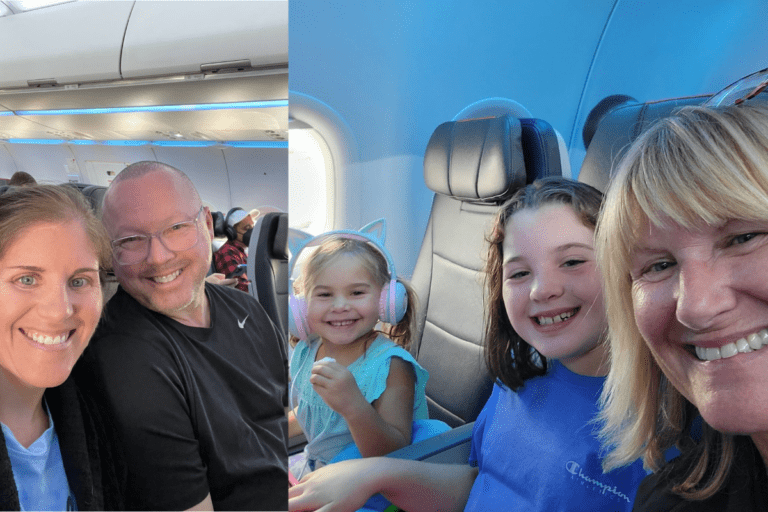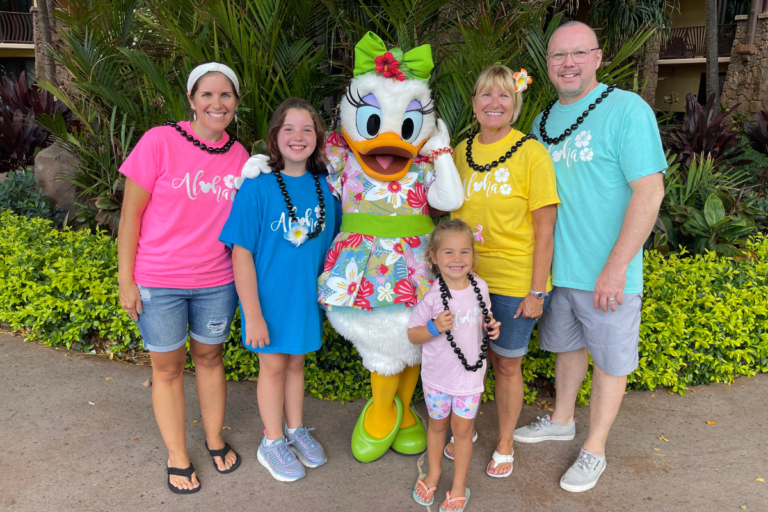Travel Tips for Time Zone Changes
Traveling time zones? Worried about how to help your little one will make the transition? Planning a vacation can be a stressful process especially when you’re traveling with kids. Not to mention the packing and then actually getting to your destination. In this post I’m sharing my top travel tips for vacation.
My family and I just returned home from a week in Hawaii which was amazing, but a lot of planning went into the trip and it was a huge time change for all of us.
One of my biggest fears when planning this trip was the thought of being on a plane with my kids for over 10 hours as well as adjusting to a 6 hour time change. All in all, it went way better than I envisioned so I’m sharing my firsthand experience.

Just Survive the Car or Plane Ride
Try to plan your departure time based on when your little one naps. Super early or late flights aren’t the best if it’s disrupting your little one’s nighttime sleep, but sometimes it’s unavoidable if you have a long trip ahead.
Let your little one sleep as much as they want in the car or on the plane. Don’t worry about the timing of naps. Wearing or holding your little one, even nursing/feeding to sleep can be helpful on the plane. It’s totally okay to “break the rules”, you’re in survival mode. Make sure you have something your child can suck on to help with the ear popping.
Bring special toys and snacks to make things more exciting and special. If you usually don’t allow screen time a lot throughout the day you’re going to want to make an exception while traveling. If your device won’t be connected to WiFi plan ahead by downloading some movies or shows before you leave.
My 4 year old slept for most of both flights, which was a lifesaver! When she wasn’t sleeping, she was snacking and watching her tablet. I was very nervous about the long flights (we had two 5+ hour flights), but both of my kids did really well. My oldest slept and did some homework as well as watching movies on the plane.
Room Environment
Depending on where you’re staying and the setup of the room try to plan ahead. If you will be room sharing try to create a divider or a separate space within the room (especially if your little one sleeps in their own room). Using a closet or bathroom for the pack and play or mini crib can make things extra dark and quiet, but it’s not always feasible.
The best solution for room sharing is to purchase or rent a Slumberpod. The Slumberpod fits over a pack and play or mini crib creating a dark and separate sleep space for your little one. This is especially helpful if you’re in a hotel room or there are no easy options to create a dark and separate sleep space.
If you travel frequently and constantly worry about lugging your room darkening shades or having to go to bed when the baby does, I promise you the Slumberpod will change your life. See the Slumberpod in action here and snag one with my $20 off code here. If you live local to me you can also rent mine for your vacation to try it out.
Along with having a dark sleep space for your little one, you want to bring anything else that signals sleep. That would include a sound machine, sleep sack, lovey, toddler clock, pacifiers, blanket and anything else that’s part of the bedtime routine.
Schedule and Routines
Your little one’s sleep will most likely be different while on vacation. They’re in a new sleep space (maybe in a new time zone) and they need time to adjust. Try to stick to their nap schedule as much as possible within reason.
Don’t overload every day with activities- try to let your little one nap in their crib or pack and play for at least one nap a day. Your child will be very fussy if overtired which won’t make for a pleasant trip. Keep bedtime close to the normal time, within 30 minutes for little ones. Older children can handle a little more variance, but buffer a late night with a normal night to avoid overtiredness.
Communicate to family and friends the importance of sleep for your child. Try to plan out activities around their nap or bedtime when possible. Having a winddown or quiet environment before sleep can help your child settle faster and avoid that FOMO when family or friends are around.
Stick to the same routine while away to help their bodies get ready for sleep. If your little one is having a tough time settling down, be patient. They may need some extra reassurance from you at bedtime. You may also experience some night wakings, early mornings or short naps while they’re adjusting.
Get on the New Time Zone Right Away
If the length of your trip is more than 3 days work on switching to the new local time right away. It will take a day or 2 for you and your little one to adjust, but you can make bedtime early or late depending on the local time.
If it’s daytime when you arrive, expose your child to daylight as much as possible to set their body clock. Adjust naps depending on how they slept in the car or on the plane. This may mean an extra nap to push back bedtime (if you lost time traveling west). You can also bring bedtime earlier if needed, but try to follow the local time. Making their sleep space extra dark will also help them fall asleep faster at bedtime.
If it’s nighttime when you arrive, your little one may not be ready for bed just yet, especially if they slept a lot in the car or on the plane. Bedtime will probably be different than when at home (try sticking to the local time). If they didn’t sleep well or it was a long travel day, get them into bed ASAP. Make sure their room is dark and do the same bedtime routine.
Split the Difference
If your trip is less than 3 days, stay on your home time or split the difference. If the time change is 2 hours, shift 1 hour and follow that while there. It will be much easier to transition back.
Additional Tips
Sunlight and darkness will help your child’s circadian rhythm adjust much faster. Follow age appropriate awake windows throughout the day and adjust bedtime as needed. Your little one may have some night wakings or early mornings while adjusting to the new time.
If your child wakes up in the middle of the night, let them stay up. Avoid screen time (blue light) during this time. Keep the lights low, read to them quietly and put them back to bed. They may need some reassurance if having trouble getting back to sleep.

When the Trip is Over
Traveling west is usually easier for us to adjust than traveling west, because we’re gaining time versus losing time. Either way, traveling across time zones is a big adjustment for our circadian rhythm and it can take our little ones up to 1-2 weeks to fully adjust.
Follow awake windows with your little one until you’re back on track. If you’ve hit a sleep regression, address it immediately. You can adopt a leave and check approach, doing check ins every 10 minutes until they’re asleep.
If your child is having a really tough time you may choose to stay in the room with them and work on easing out of their room. If they were an independent sleeper before avoid bringing them to bed or getting into bed with them. Depending on how much sleep has regressed you may need to “reset” and sleep train again.
We’ve been home for a few days now and my youngest had a tough night or two settling to sleep. I’ve had to go in multiple times to do check ins and even sit next to her bed while she calmed down. While it was especially frustrating for me, I had to remind myself that in Hawaii time it was 6 hours earlier and her little body is still adjusting back to East Coast time.
Try to remember that traveling gets easier as they get older. Sleep will be different while traveling and that’s okay. Planning ahead can help, but things won’t always go according to the plan.
Once your back home you can always get sleep back on track. If you find yourself needing a some direction and support reach out! You can book a free call with me here. If you’re not traveling soon save this post for later. As a bonus download my free travel tips guide.

